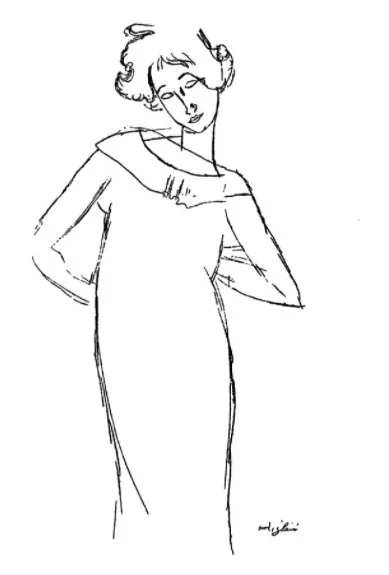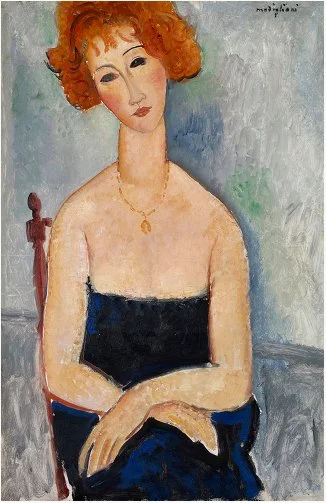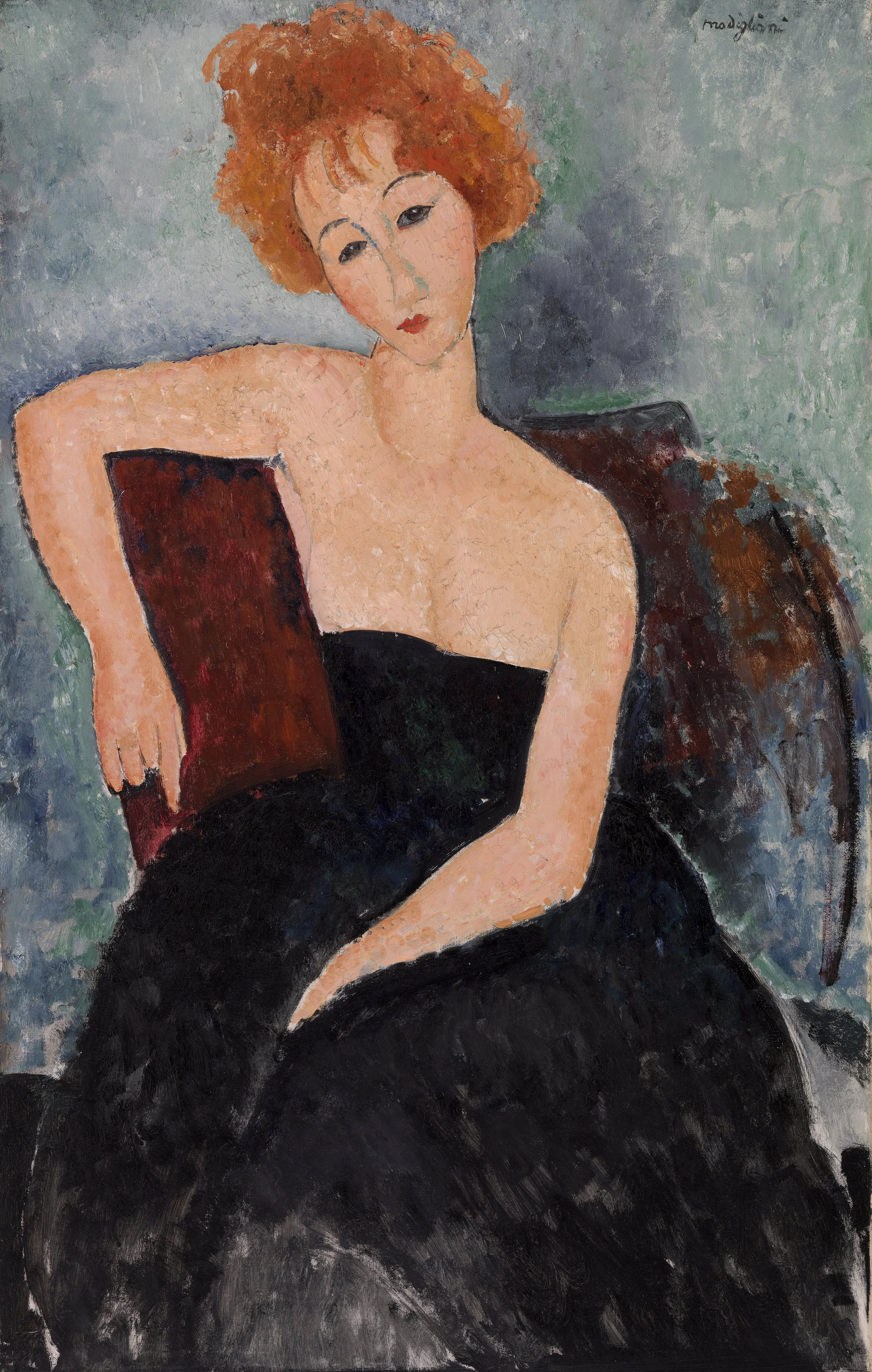Marie Beerbohm
(fig. 1) Woman with Red Hair, 1917. National Gallery of Art, Washington, D.C. Chester Dale Collection.
November 1, 2022
A Thoroughly Modern Woman
Mr. Edward Wolfe thinks this may be Marie Beerbohm,
niece of Max Beerbohm.
This handwritten addendum appears at the bottom of the original typed record for Woman with Red Hair, a painting dated 1917 in the Chester Dale Collection at the National Gallery of Art, Washington, D.C. (fig. 1) Mary Bullard, the inscription’s likely author, was Maud Dale’s long-time assistant who kept meticulous records of the rapidly growing art collection. The Dales purchased the painting in March 1928 and when it was shown three years later the title was given as Portrait, Mlle. P. de C. Edward Wolfe may have been trying to set the record straight; having known Marie well, he was in a position to identify her.
Marie Marguerite Beerbohm (1890–1928) was born into a wealthy family in London, the only daughter of Evelyn Davies and her third husband Julius Beerbohm, an explorer, engineer, and author. Julius’s half-brother Max Beerbohm, also a writer, was a well-known caricaturist. The family had close ties to the theater through Marie’s uncle Herbert Beerbohm Tree, an actor and respected theater manager. Her brother Clarence “Evelyn” Beerbohm became a beloved comedy actor before he died on the front line in October 1917.
Her parents were jet setters, traveling frequently from London to Paris and the French Riviera where Marie was also known to have spent time. She was living on her own in London and studying music by the time she was 21 and in 1912, she married Ernest Alexander Stuart Watt, a divorced Australian whose wide-ranging credentials included barrister, businessman, poet, arts patron, and teacher. Their marriage was short-lived and Watt filed for an annulment a year later.
(fig. 2) “Mrs. Wilfred Gough [left] and Miss Marie Beerbohm,” The Tatler no. 885 (June 12, 1918): 292.
Marie Beerbohm was fondly remembered by those who knew her as a free spirit; one friend went so far as to describe her as “dissolute” possibly due to a string of dalliances. Her life seemingly began after her divorce and can be pieced together through official records and mentions in the society pages, as well as in the diaries, memoirs, and biographies of her illustrious friends. (fig. 2) The woman in the Dale portrait bears a striking resemblance to the subject of two drawings published during Modigliani’s lifetime in the magazine L’Eventail (fig. 3) and to two other paintings: The Redhead with the Pendant (fig. 4; Private collection) and Portrait of the Red-Headed Woman (fig. 5; Barnes Foundation).
(fig. 3) Untitled drawing, L'Éventail: Revue de Littérature & d'Art (August 15, 1919): 243.
(fig. 4) The Redhead with the Pendant,
1918. Private collection.
All three portraits depict a stylish woman with curly red hair and dark eyes; her head is cocked at the same jaunty angle in each. Judging by her confident poses and her attire—ranging from fashionable to daringly revealing—Modigliani’s model knows her place in society and defiantly returns his gaze. She represents the newly emerging, contemporary female. With her hair cut short and her facial features enhanced by make-up, she is aware of her sensuality and is uninhibited. Marie Beerbohm, a divorced, English socialite in her late-20s, had met or would soon come to meet many in the artist’s Parisian circle (see below) and had prior experience as an artist’s model. From what we know about her life, she compellingly meets the criteria as presented in Modigliani’s visual description. In some ways, Beerbohm and Modigliani were not dissimilar. Her reckless lifestyle may have played a role in her premature death—a decade after these portraits were painted—when she was just 37.
Julia May Boddewyn
_________________
“Who’s Who”
The well-known individuals who considered Beerbohm a friend, most of whom were also friends of Modigliani:
Edward Wolfe (1897–1982) moved to London from South Africa in the fall of 1915 and, after attending the Slade School of Art, worked for the Omega Workshops, the design studio founded by the pioneering art critic Roger Fry with the artists Duncan Grant and Vanessa Bell. There he met Nina Hamnett who introduced him to her friend Marie Beerbohm.
Nina Hamnett (1890–1956), the Welsh artist, worked for the Omega Workshops during the war. She had lived in Paris in 1914 where she befriended Modigliani and was responsible for introducing him to the English writer Beatrice Hastings (1879–1943). After the war began, Hamnett returned to London where she met Edward Wolfe and introduced him to Beerbohm, a friend she describes in her memoir as a “charming girl . . . tall and thin and elegant.” By 1920, both women had moved to Paris where Hamnett lived in the studio at 8 rue de la Grande-Chaumière that had until recently been occupied by Modigliani and Jeanne Hébuterne.
Jacob Epstein (1880–1959), the American-turned-British sculptor, lived in Paris briefly in spring 1913 and there met and became friendly with Modigliani. Back in London in 1915, Epstein portrayed Beerbohm in bronze; this sculpture received abundant attention when it was included in an exhibition of his work two years later. (fig. 6) The critic for The Sketch wrote: “Marie Beerbohm, charmingly light in her slightly bored pose, has the somewhat affected petite face of the mondaine tilted up as if ready for a yawn or a mocking laugh.”
(fig. 6) Jacob Epstein, Marie Beerbohm, 1915, Private collection. Reproduced in John Quinn, “Jacob Epstein, Sculptor: A Note on the Man and His Work,” Vanity Fair 9, no. 2 (October 1917): 76
Jean Cocteau (1889–1963), the well-known French poet, was the subject of a Modigliani painting in 1916. Beerbohm introduced Nina Hamnett to Cocteau sometime after 1920 when both women were living in Paris.
Raymond Radiguet (1903–1923) was a poet and a part of Modigliani’s circle from a surprisingly young age. He was romantically linked to Beatrice Hastings in 1921, five years after her separation from Modigliani, and subsequently began seeing Beerbohm after his own split from Hastings.
Manuel Ortiz de Zárate (1887–1946), the Chilean artist, was one of Modigliani’s oldest friends and his neighbor at 8 rue de la Grande-Chaumière. In 1923, Ortiz de Zárate painted Beerbohm’s portrait. (fig. 7)
(fig. 7) “Marie Beerbohm, Paris, by Ortiz de Zárate, 1923”
Nancy Cunard Papers, Scrapbook 3, 1919–1929. Harry Ransom Center, The University of Texas at Austin
Note:
It has been suggested that the model for these paintings could be Marie Beerbohm’s cousin Viola Tree (1884–1938). Tree was a successful actress in London who married in 1912 and by 1917 had two sons and a daughter on the way. She was known to have been a redhead and her youngest sister Iris Tree (1897–1968) had fiery red hair as depicted in two portraits by Augustus John. To date, a color image of Marie Beerbohm has not been found but she may have shared this family trait.
Sources
[Reproductions of four untitled Modigliani drawings], L'Éventail: Revue de Littérature & d'Art (August 15, 1919): 225, 243.
Portraits of Women: Romanticism to Surrealism exh. cat. (New York: Museum of French Art, 1931), no. 28, Portrait Mlle. P. de C., Chester Dale Collection.
Mary Butts, The Journals of Mary Butts, Nathalie Blondel, ed. (New Haven and London: Yale University Press, 2002), 397.
Anne Chisholm, Nancy Cunard (New York: Alfred A. Knopf, 1979).
Nina Hamnett, Laughing Torso: Reminiscences of Nina Hamnett (London: Virago Press, 1984). Available on Internet Archive: https://archive.org/details/laughingtorsorem0000hamn
Denise Hooker, Nina Hamnett: Queen of Bohemia (London: Constable and Co., Ltd., 1986).
Nancy Ireson and Anya Shutova, “Portrait of the Red-Headed Woman,” in Modigliani Up Close exh. cat. (Philadelphia: The Barnes Foundation; distributed by Yale University Press, New Haven and London, 2022), 195.
Lady Ottoline Morrell, Ottoline at Garsington: Memoirs of Lady Ottoline Morrell, 1915–18 (London, 1974), 200.
Nicholas Murray, Aldous Huxley: A Biography (New York: Thomas Dunne Books, 2003).
John Quinn, “Jacob Epstein, Sculptor: A Note on the Man and His Work,” Vanity Fair 9, no. 2 (October 1917): 76, 114.
Marthe Troly-Curtin, “The Art of Jacob Epstein,” The Sketch XCVII, no. 1256 (February 21, 1917): supp. p. 2.
Edward Wolfe: https://www.tate.org.uk/art/artists/edward-wolfe-2160, accessed June 8, 2022.
Archival Material:
Nancy Cunard Scrapbooks, Harry Ransom Center, The University of Texas at Austin
Ancestry Library Edition, Ancestry.com
Death record of Marie Marguerite Beerbohm, December 26, 1928. Mairie de Cambes, Gironde, France.
Special thanks to Anne Halpern, Museum Specialist, Department of Curatorial Records, National Gallery of Art, Washington, D.C. for pointing out the Edward Wolfe note about Marie Beerbohm. Email dated May 6, 2022.
The Modigliani Initiative








